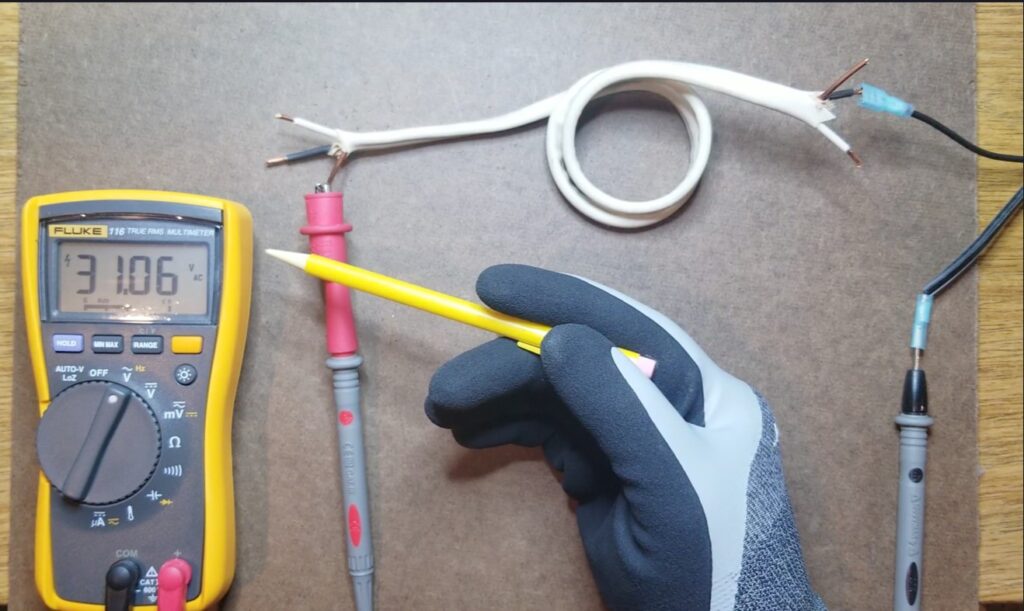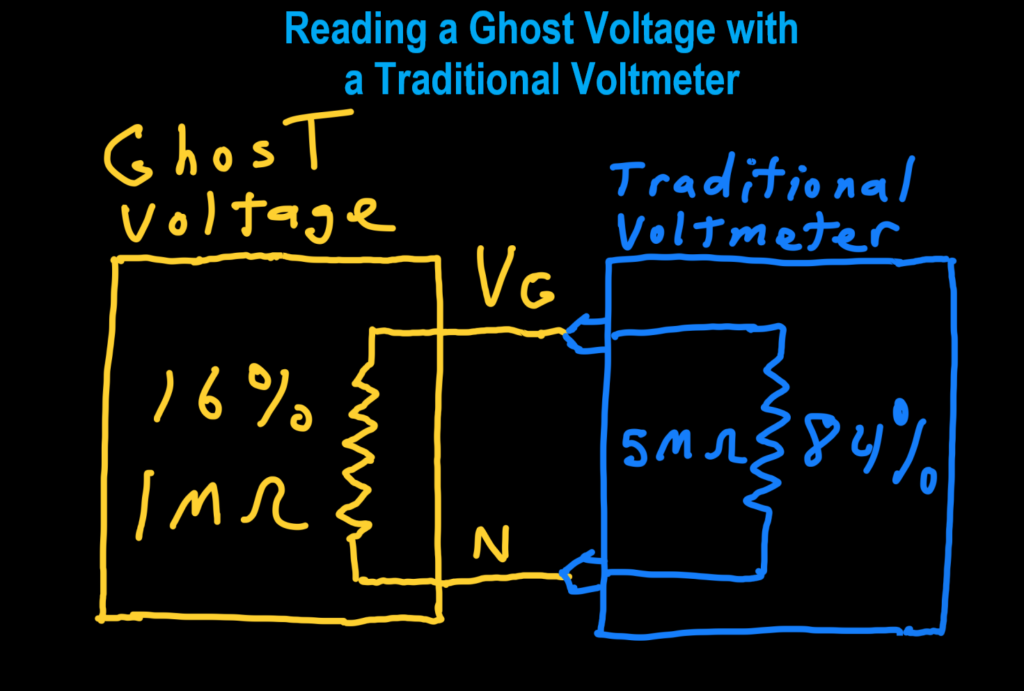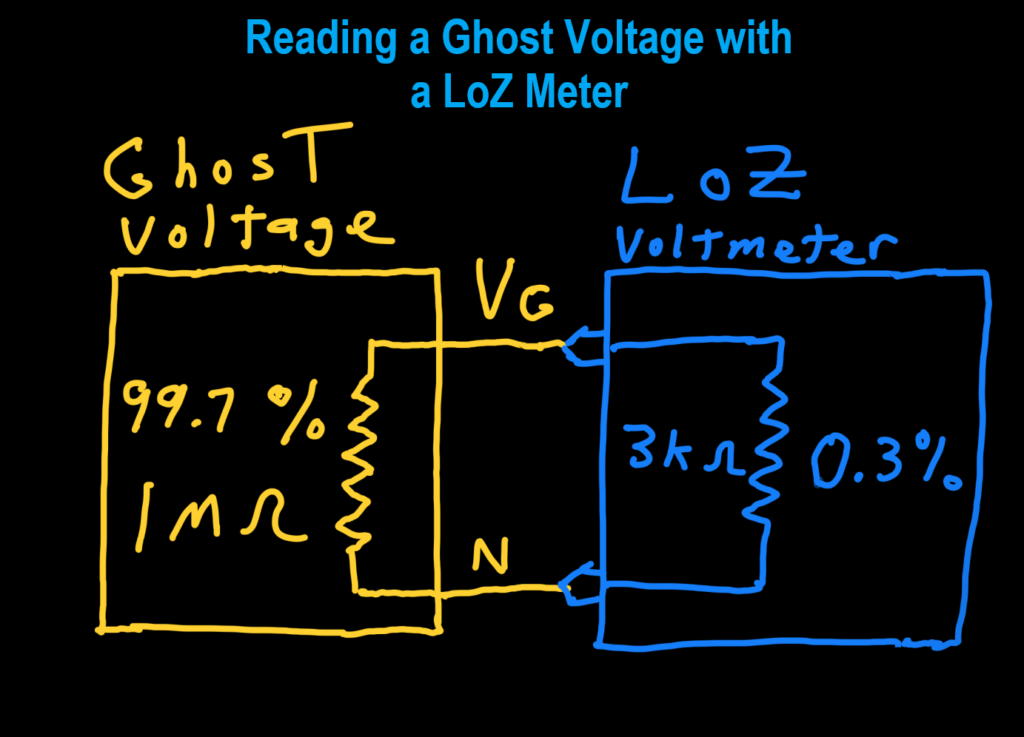A “ghost voltage” is an electrical potential that appears on an undefined conductor due to capacitive coupling via proximity to other conductors or by electromagnetic induction. A ghost voltage has almost no ability to source any current and may simply disappear if any kind of a load is connected to it. Further, a ghost voltage may register on a traditional digital volt-meter because the high-input impedance of such meters sometimes isn’t enough to bleed that ghost voltage off.
Ghost Voltage Demonstration
Below is an example of a ghost voltage derived from capacitive coupling within a Romex bundle. The black wire is energized with 120 volts AC with respect to neutral. The bare copper wire is an undefined conductor and connected to nothing. However when measuring the voltage on that bare copper wire the volt meter when in traditional voltage reading mode reads 31 volts. This voltage is unable to supply any practical amount of current and will quickly disappear when a load is placed on it. It can, however, throw off the unwary Technician that is expecting to read zero volts – and send them on a wild goose-chase.

Be sure to subscribe to our Youtube Channel!
For tons of videos on electrical and electronics diagnostics, practical electrical theory, and field-technician resources, click the picture below or this link here: https://www.youtube.com/@TheTechCircuit?sub_confirmation=1

Standard Voltmeter Operation
When measuring the ghost voltage with a traditional digital multimeter, the high input impedance, which is typically around 5 million ohms, is typically unable to put enough load on the ghost voltage to shut it down completely. Thus, you may read a voltage, thinking that it is a valid voltage for that conductor. The image below depicts this scenario. If the ghost voltage output impedance is around 1M ohms, the 5M ohm input impedance of the meter will still read over 80% of the ghost voltage.

Using LoZ to Shut Down a Ghost Voltage
When suspecting a ghost voltage, you can switch your meter to LoZ mode, which has an input impedance of around 3k ohms. This relatively low input impedance there’s enough to make many types of ghost voltages completely disappear, particularly capacitively coupled ones as in the demonstration image above and in the video at the end of this blog. For example if the ghost voltage again had an output impedance of around 1M ohms, the 3k ohm input impedance of the LoZ meter would only allow about 0.3% of that ghost voltage to appear across the meter, giving a reading of close to 0 volts. In this manner, using the LoZ meter can easily tell you that what you were reading was a ghost voltage.

Ghost Voltage Demonstration Video
Below is a video demonstration of how an actual ghost voltage is derived, and distinguished between a valid voltage by using a LoZ meter. Using such a LoZ meter can save the Technician time and wasted effort by avoiding the “bait and switch” nature of such voltage anomalies.
Click Below to Purchase the Fluke LoZ Multimeter

Test Your Knowledge of Ghost Voltages!
Take the quiz below to test what you learned in this blog. Answers are provided at the end.
Understanding Ghost Voltages
Select the best answer for each question.
Conclusion
A ghost voltage can exist almost like a static charge – a build-up of potential that has virtually no agility to source current. This state means that with a traditional digital Volt meter, you may read that ghost voltage because of the high impedance input of that meter. Using the low Z function of a voltmeter puts a small load on that conductor because of the relatively low 3K ohm typical input impedance. That typically you can bank those voltages disappear, letting you know that what you were reading was not a valid voltage for that conductor.
Don’t forget:
“Diverting 10 min/day of social media time towards learning something new, is 5 hours of newfound monthly knowledge.” – SM
To DONATE to the Tech Circuit – CLICK HERE
Alphabetical Links to all Tech Circuit Articles and Blogs – CLICK HERE
Links to all Tech Circuit Cheat Sheets/Field References for Appliance/HVAC Techs – CLICK HERE
For additional electrical and electronics learning material for field techs, visit the following links:
Homepage at http://www.TechCircuit.org
Facebook group at: https://www.facebook.com/groups/746823709133603
Youtube Channel: https://www.youtube.com/@TheTechCircuit
We are a participant in the Amazon Services LLC Associates Program, an affiliate advertising program designed to provide a means for us to earn fees by linking to Amazon.com and affiliated sites.
